
‘Baby Taj’ or Itimad-ud-Daulah and one of the gates

Incredible detail work went into the tomb.
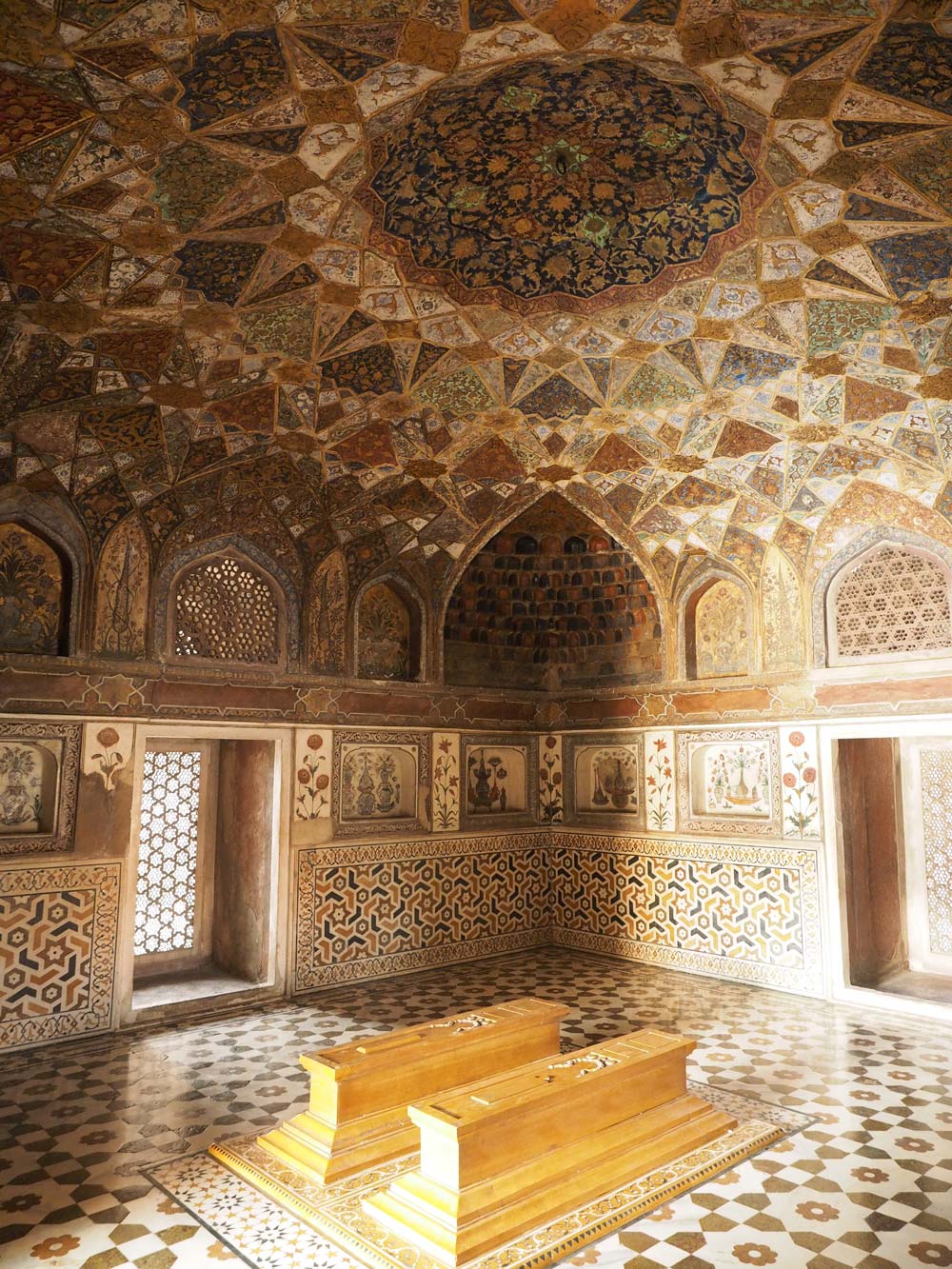
The dazzling interior

Pietra dura detail

This gate overlooks the Yamuna River

‘Baby Taj’ or Itimad-ud-Daulah
and one of the gates

Incredible detail work
went into the tomb.

The dazzling interior

Pietra dura detail

This gate overlooks
the Yamuna River
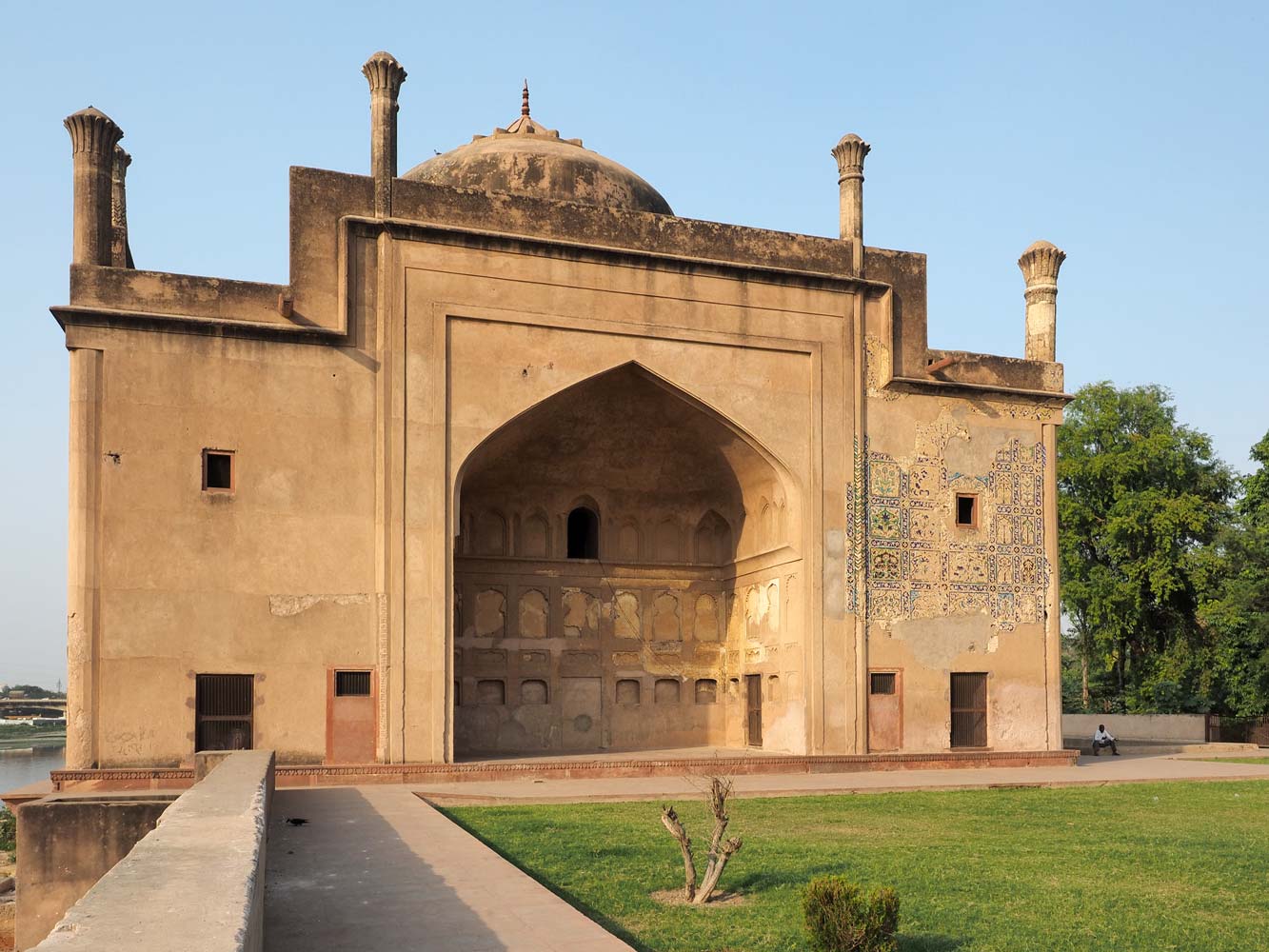
Only a hint of decorative
detail survives on Chini-ka-Rauza.

Muted colors still
amaze visitors.

The Taj Mahal stands
across the Yamuna from Mehtab Bag.
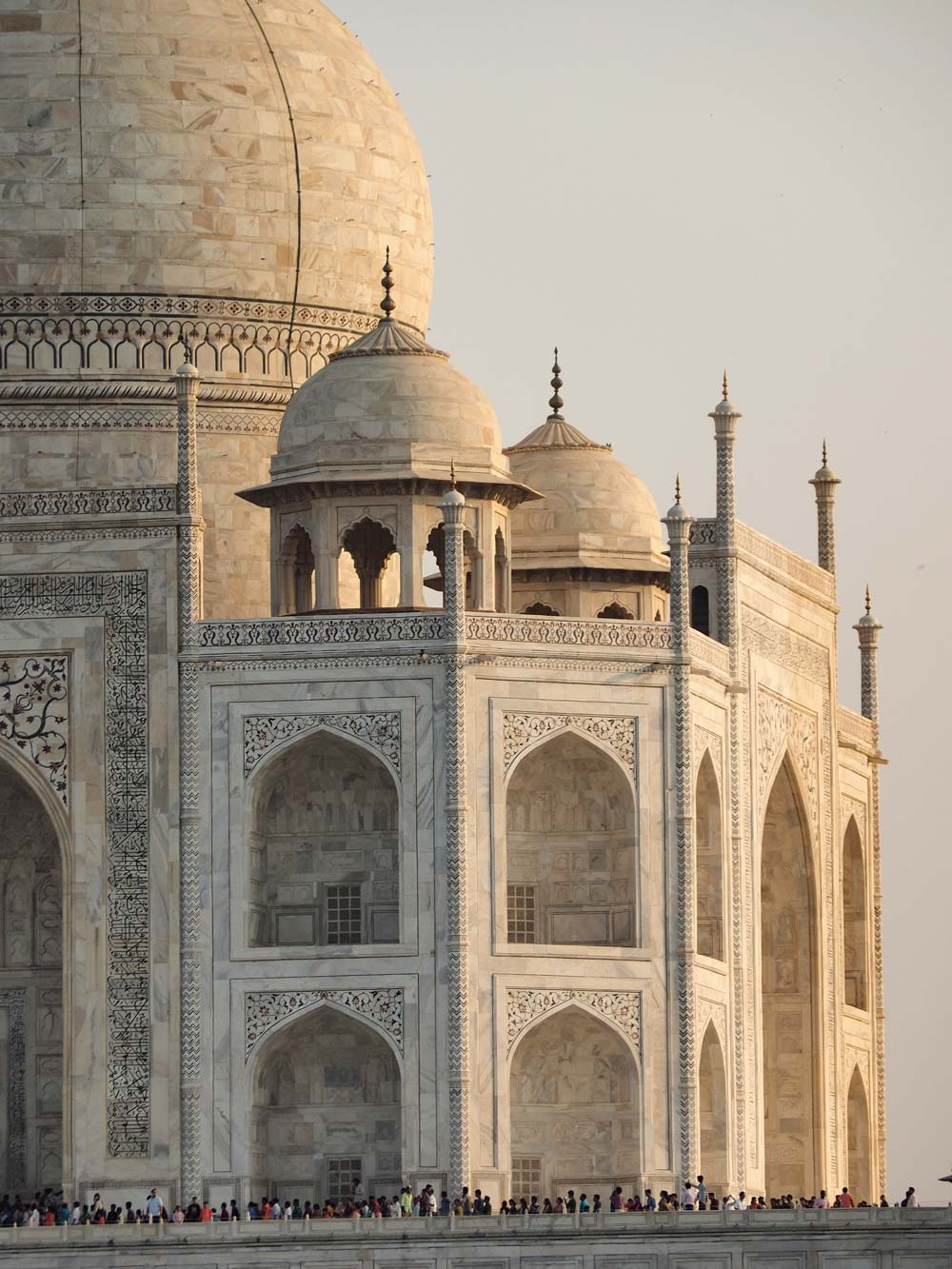
The west side of the
Taj Mahal glows late in the afternoon.
Back in Taj Ganj I had a disappointing thali at one of the many travelers’ restaurants.
Food and accommodation have been a big step down from what I enjoyed in Jaipur.
29 Oct. Agra
Last night got noisy due to bouts of barking dogs, music, and traffic,
so I stuffed my ears with earplugs, then I had a good night’s sleep. However I didn’t
hear the early-morning alarm, intended so that I could head to the Taj Mahal around
first light, said to be the best time to arrive. Instead I went out for a leisurely
breakfast and decided to try again for a Taj visit tomorrow morning.
India is full of abandoned ancient cities, and one of the best lies about 40 kilometers
west at Fatehpur Sikri. Emperor Akbar built this magnificent capital from 1571 to
1585, but his successors abandoned the site, perhaps in part due to water shortages.
First I got an autorickshaw for the long ride to Idgah Bus Stand on Agra’s western
outskirts, then caught a basic bus (with rock-hard suspension) for about an hour’s
journey. At the end of the ride I climbed up to the enormously imposing 54-meter-high
Buland Darwaza (Victory Gate) and entered Jama Masjid. A colonnaded cloister wraps
around a vast courtyard with the main mosque—still in use—on the west. A white marble
tomb of Sufi saint Shaikh Salim Chishti on the north side of the courtyard attracted
a steady stream of people paying respects. Light beautifully enters its latticed
walls. Just to the east stands the large red-sandstone tomb of Islam Khan, Shaikh
Salim Chishti’s grandson. Many other graves cluster nearby. After the Jama Masjid
visit, I retrieved my shoes and headed out the east gate to the palace complex,
full of grand palaces, halls, courtyards, gateways, gardens, and servants’ quarters—all
with elaborately carved stone decorations.
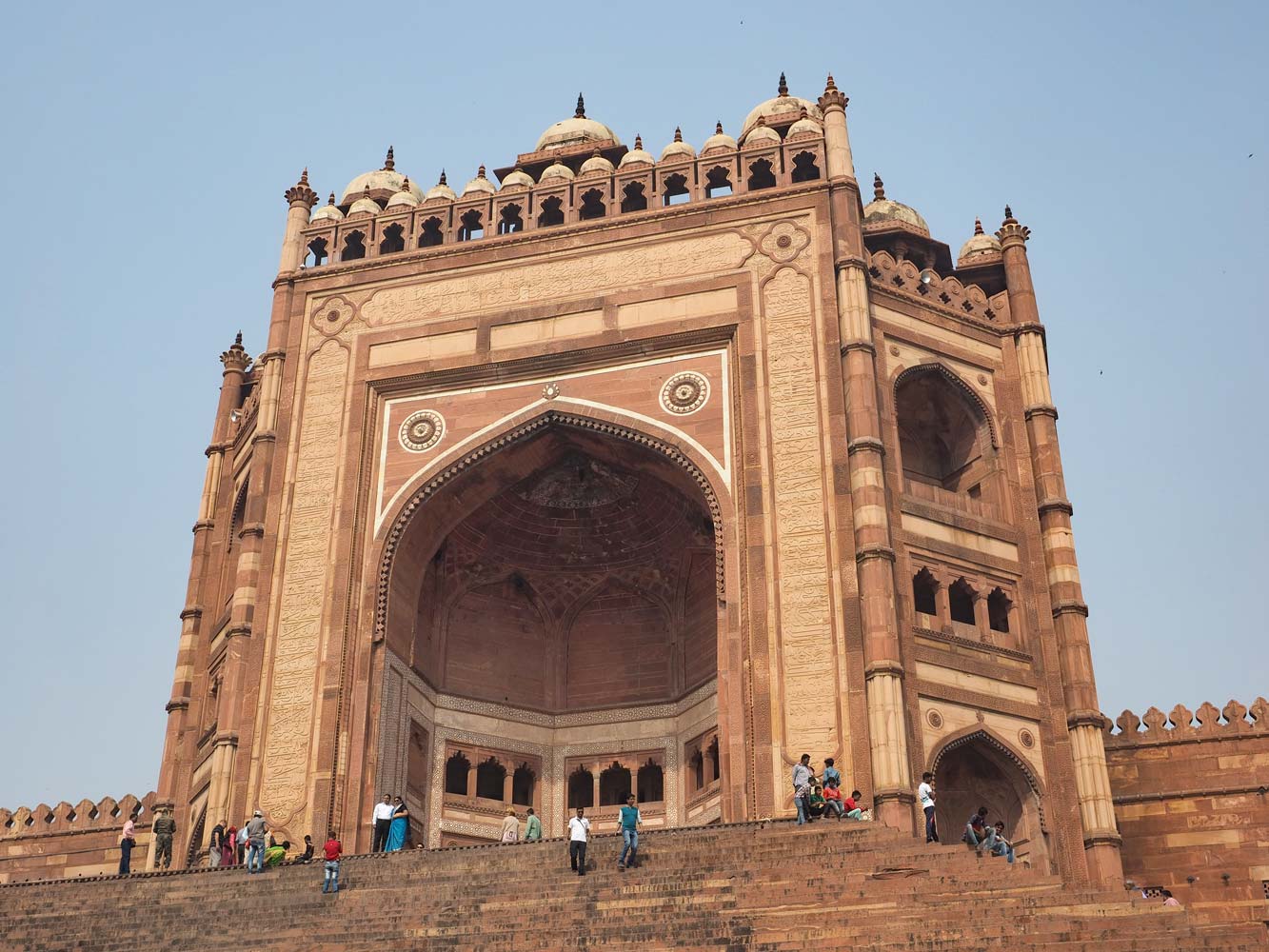
The 54-meter-high
Buland Darwaza (Victory Gate)

Another gate of Jama
Masjid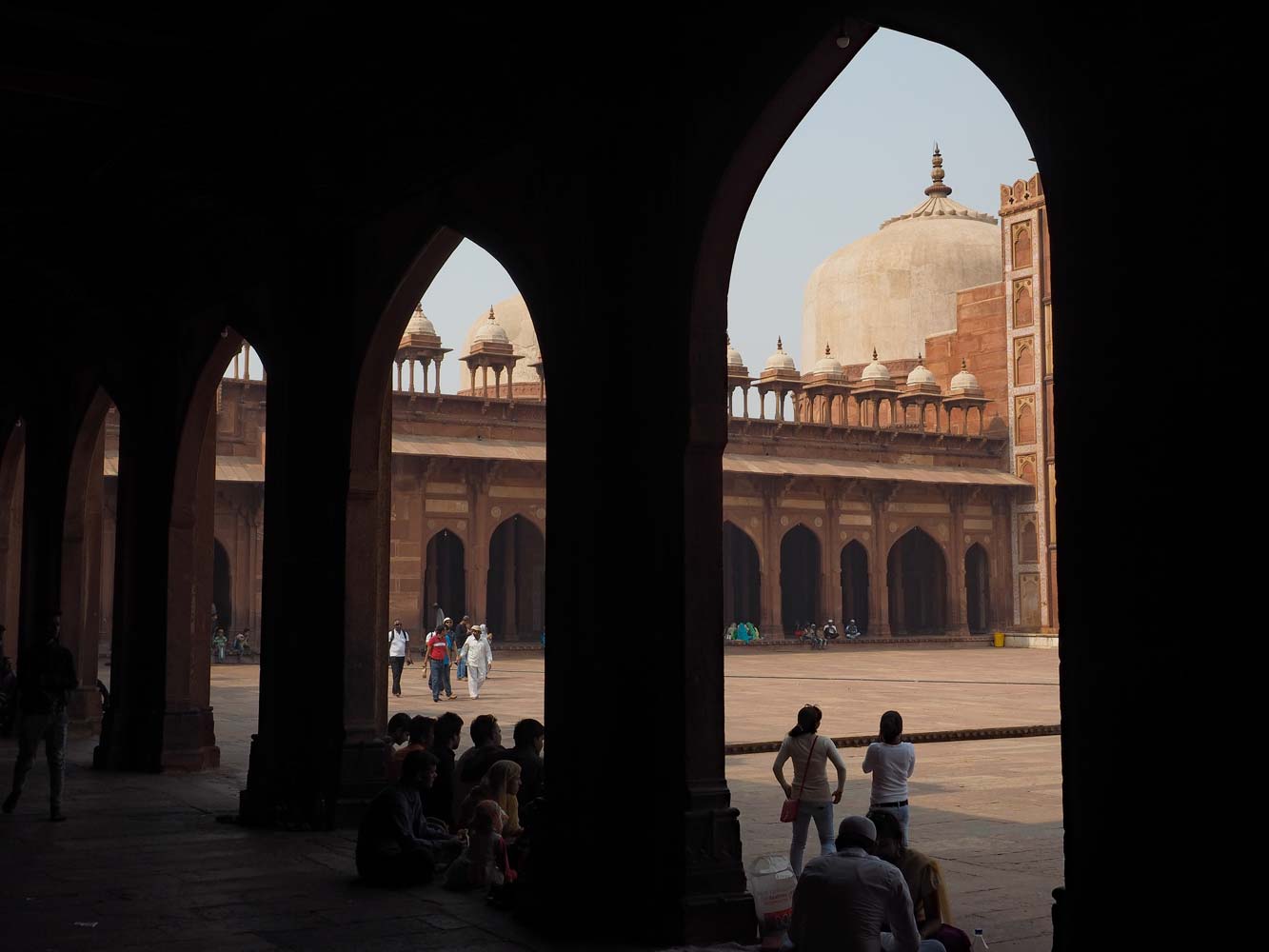
Cloister
and courtyard of Jama Masjid
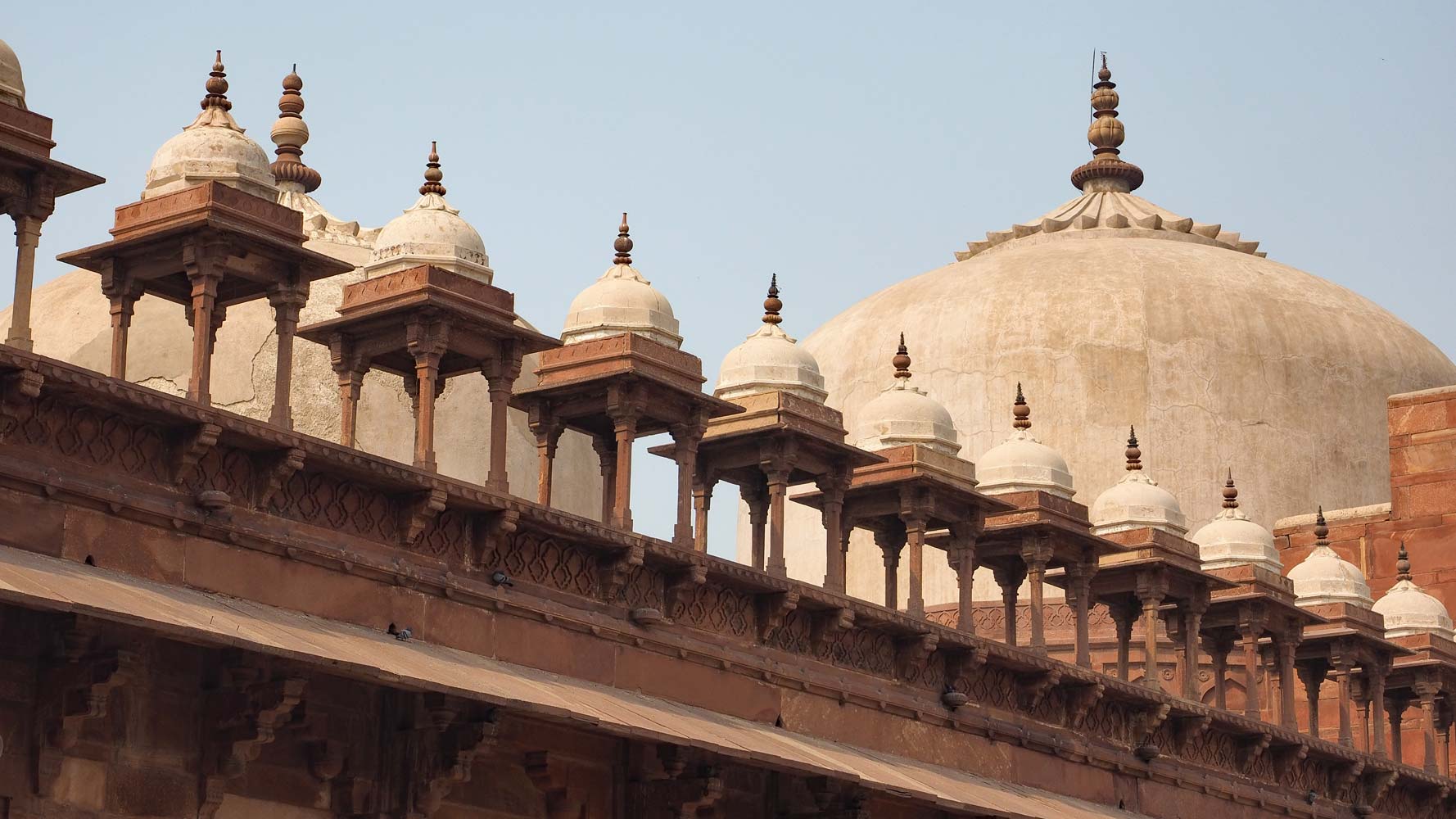
Cloister-top decorations
of Jama Masjid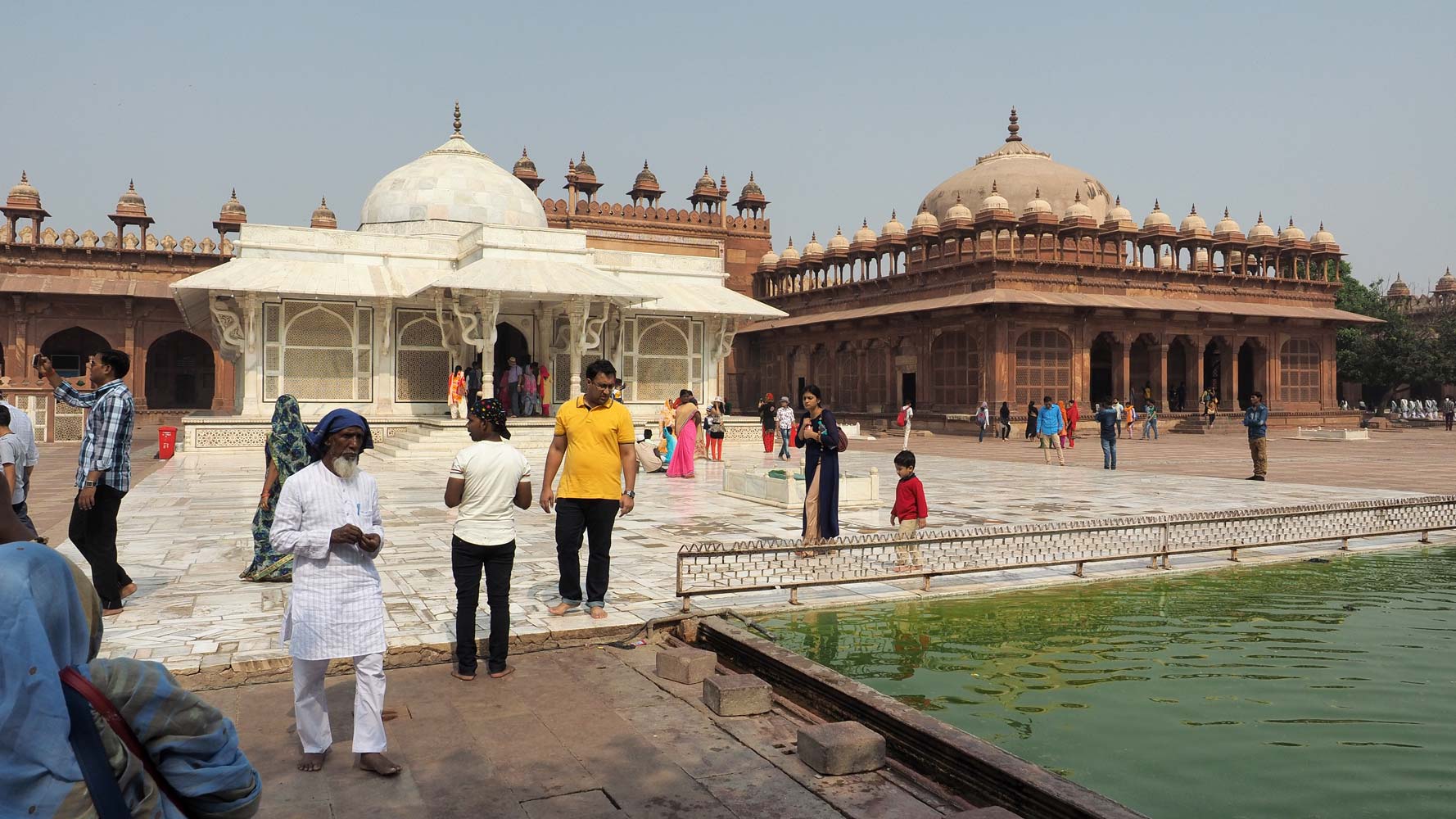
The white marble tomb of Shaikh Salim Chishti and the red-sandstone tomb of
Islam Khan in the Jama Masjid courtyard

People pay respects
in the tomb of Shaikh Salim Chishti.
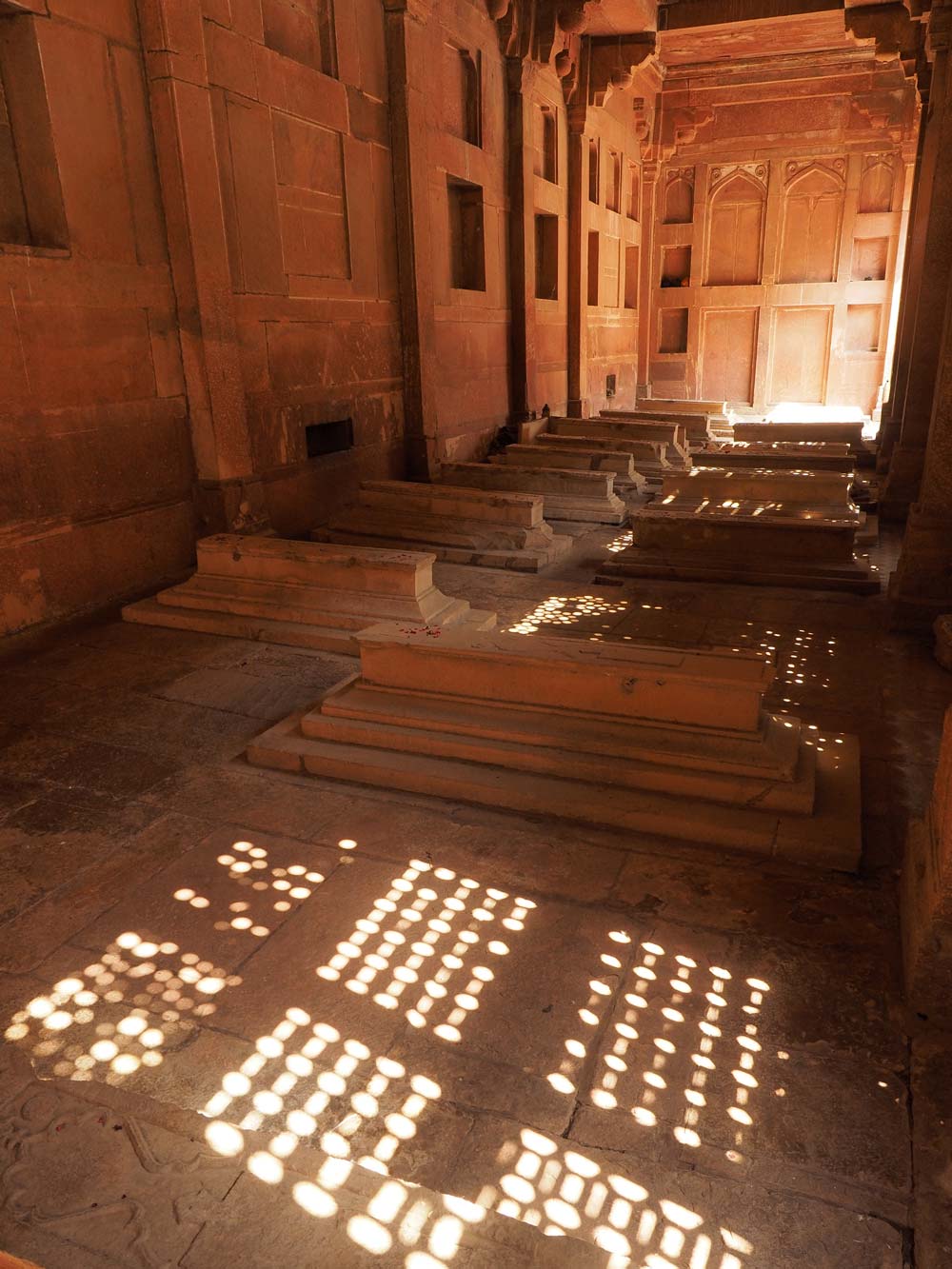
Grave markers in the
tomb of Islam Khan
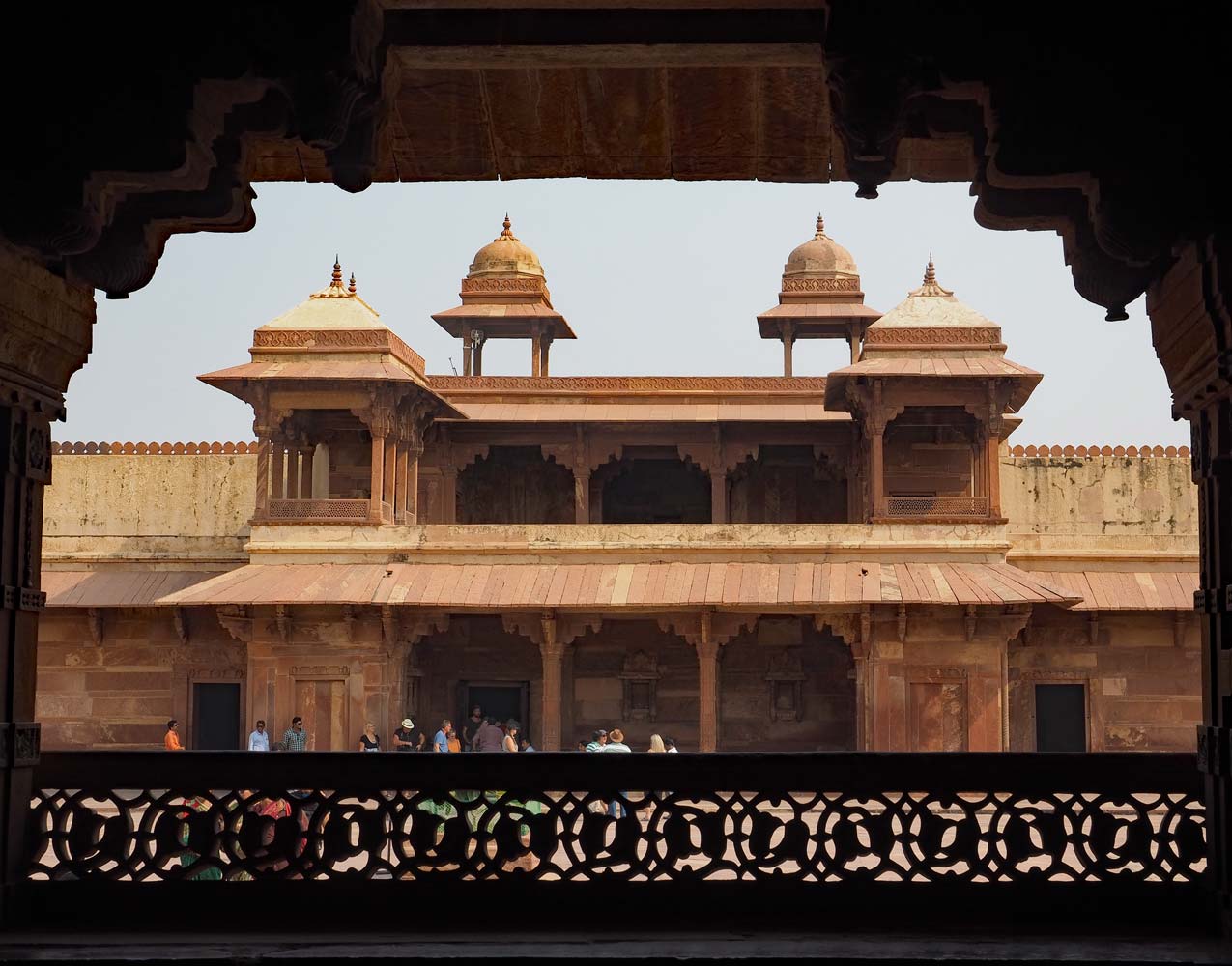
Jodha Bai’s Palace

The 1571 Birbal
Palace is believed to have housed Akbar’s senior queens, Salima Sultan Begum
and Ruqayya Begum.

Also known as “Badgir,” which means “wind catcher” or “tower,”
Panch Mahal stands
close to the Zenana quarters or Harem, serving as a pleasure palace.

Panch Mahal has
176 intricately carved columns on the bottom floor.
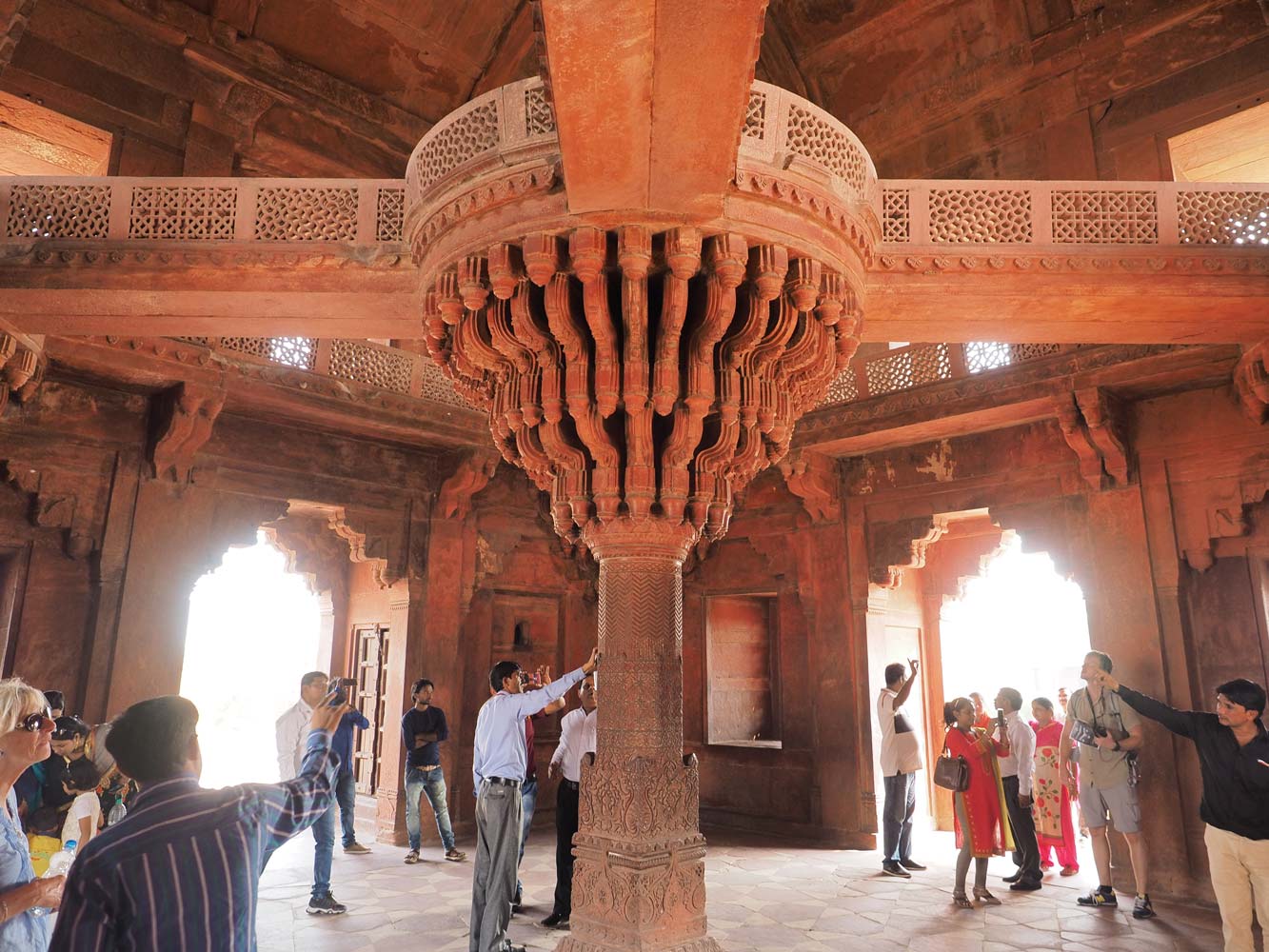
The Diwan-i-Khaas or
Hall of Private Audience is a plain square building famous for its
central pillar.
Thirty-six serpentine brackets support a circular platform for Akbar, which
is
connected by four stone walkways to each corner of the building on the first floor,
where
Akbar had representatives of different religions discuss their faiths and
gave private audience.
Back at the bus stop, I grabbed a snack of vegetable pakora (fried battered vegetable
balls) and tea before getting on another rough-riding bus back to Agra. Tonight
I hoped to have a good dinner, so took an autorickshaw to Dasaprakash (Meher Theater
Complex on Gwalior Rd.) for a super-tasty South Indian thali, then finished with
one of the many fancy ice cream deserts. When I returned to the guesthouse, the
room lights didn’t work, so I moved across the hall. This room seemed quieter, though
clambering monkeys just outside the window made a ruckus before settling down. The
night turned out relatively quiet.
30 Oct. Agra
This morning I got
an early start to see the Taj Mahal, said to be at its best in the morning light
before the big crowds arrive. Unfortunately everybody knows this and I found the
Taj just as crowded early morning as later on, but the light had a wonderful soft
quality as the red sun rose into the hazy sky.
The Taj has three entrances,
and I headed to the south one as it’s closest, but a shopkeeper told me that this
one doesn’t open until 8 a.m. He led me to the west gate, which already had a long
line. I bought the pricey 1000-rupee ticket, then headed to the back of the line.
A ‘guide’ offered to usher me in without waiting for the fee of 2,000 rupees, which
quickly dropped to 1,500 rupees, but this was a scam. It turned out that there’s
a special and very short line for tourists, who pay many times what Indians do,
and I quickly got in and through the security check. All three gates lead into the
forecourt, then one turns north and enters the huge and intricately decorated 30-meter-high
Main Gate for the first grand view of the glowing white marble Taj Mahal. A raised
platform provids a fine vantage point across reflecting pools that divide the formal
garden into four quadrants.
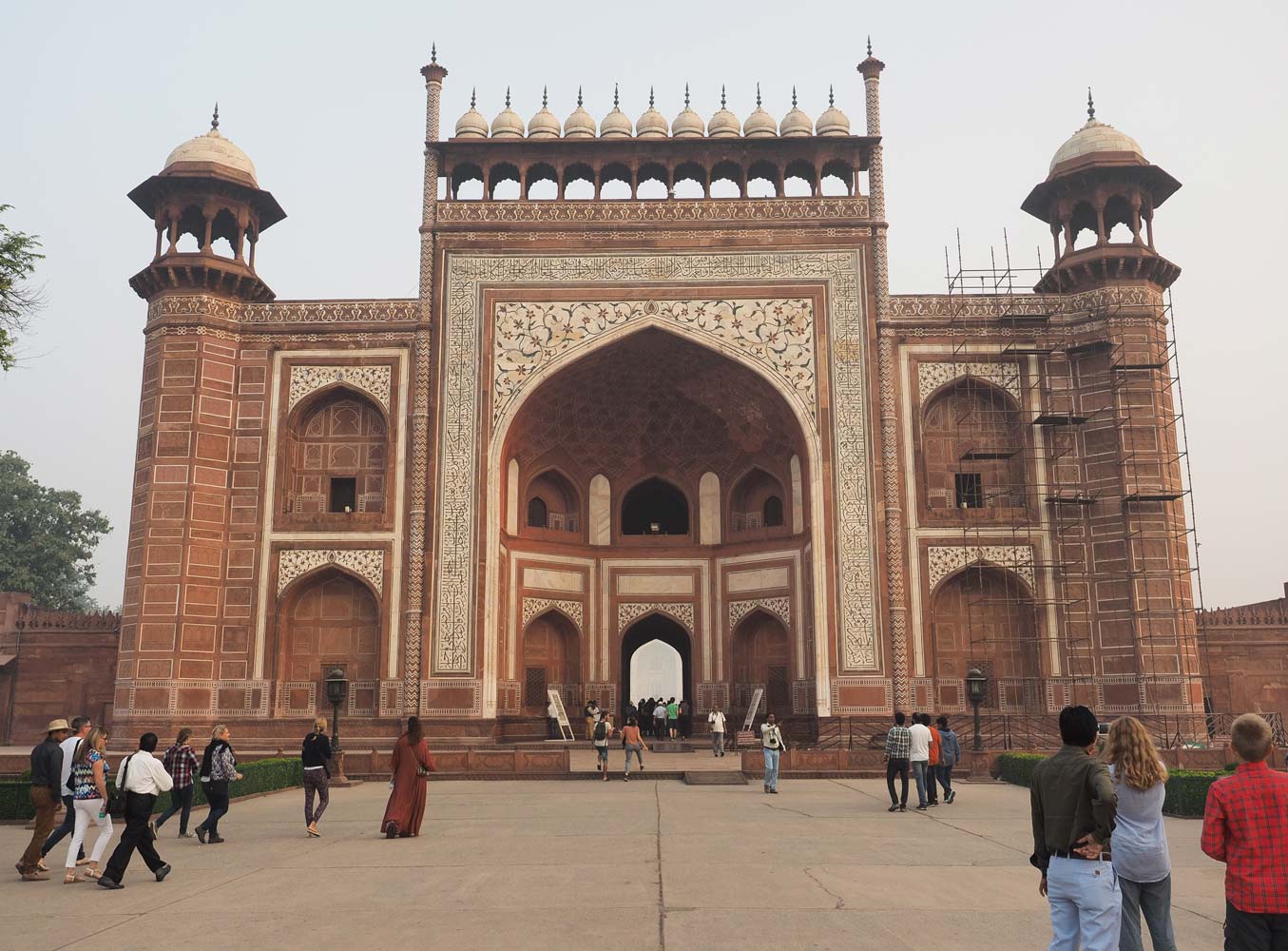
I approach the Main
Gate.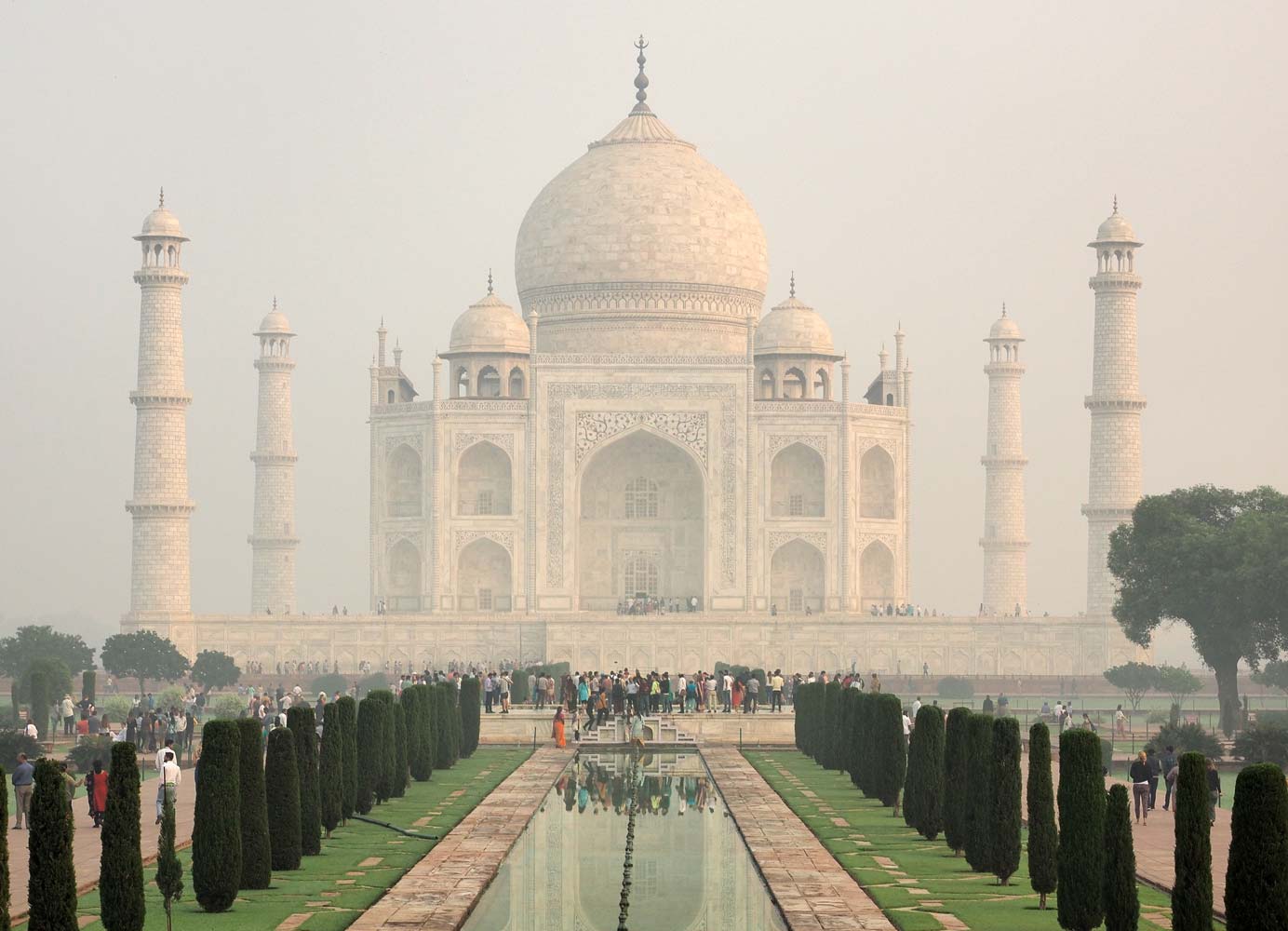
Then enjoy
this view on the other side.

A prime selfie spot!
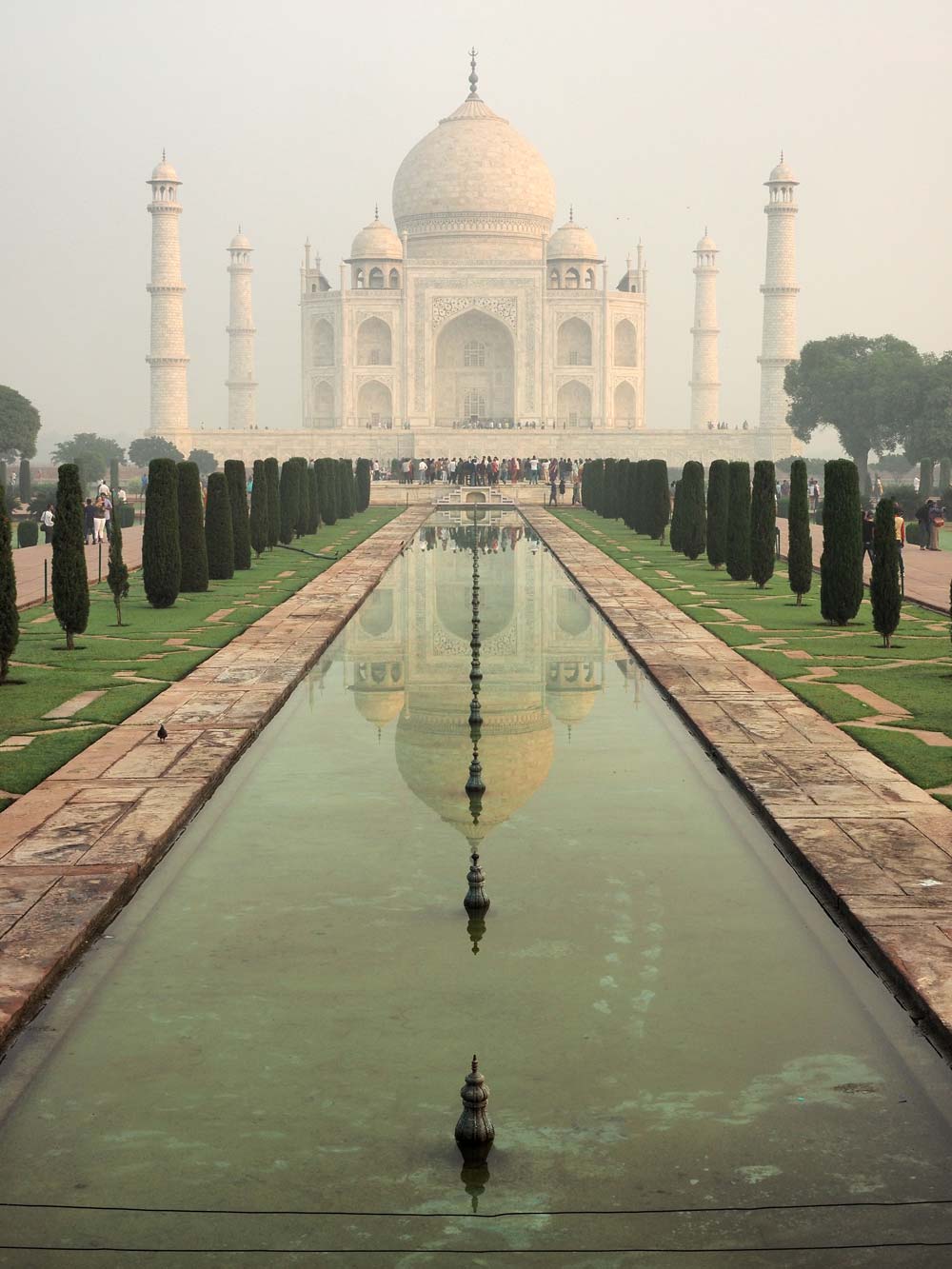
The classic reflecting
pool view
Farther along I clambered up to another raised platform that’s in the center of the garden for an even finer view. The great monument has marvelous symmetry, of course, and lots of detail with Islamic inscriptions around the great openings on each side and lots of pietra dura inside and out. A neat thing about the Taj is how beautiful it looks whether viewed from a great distance or close up. Next I walked around the Taj with detours to a mosque on the west side and an identical building called the ‘Jawab’ on the east side whose sole purpose is to provide symmetry with the mosque. Delicate pavilions mark the corners of the compound where it overlooks the Yamuna River.

A pool wraps around
a raised platform in the center of the garden.

View from the Jawab
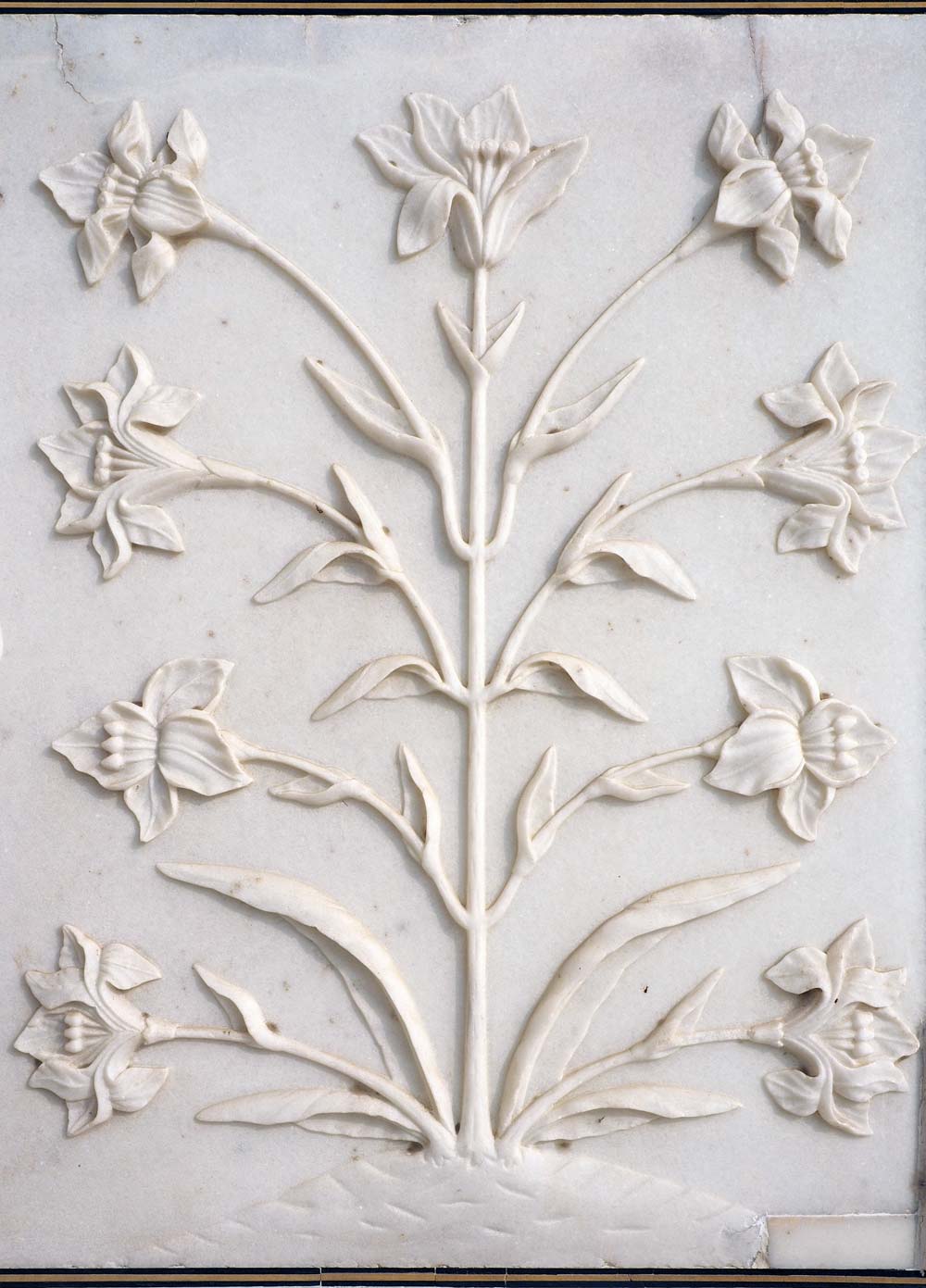
Blooms frozen in
marble
Pietra
dura frames floral still lifes.
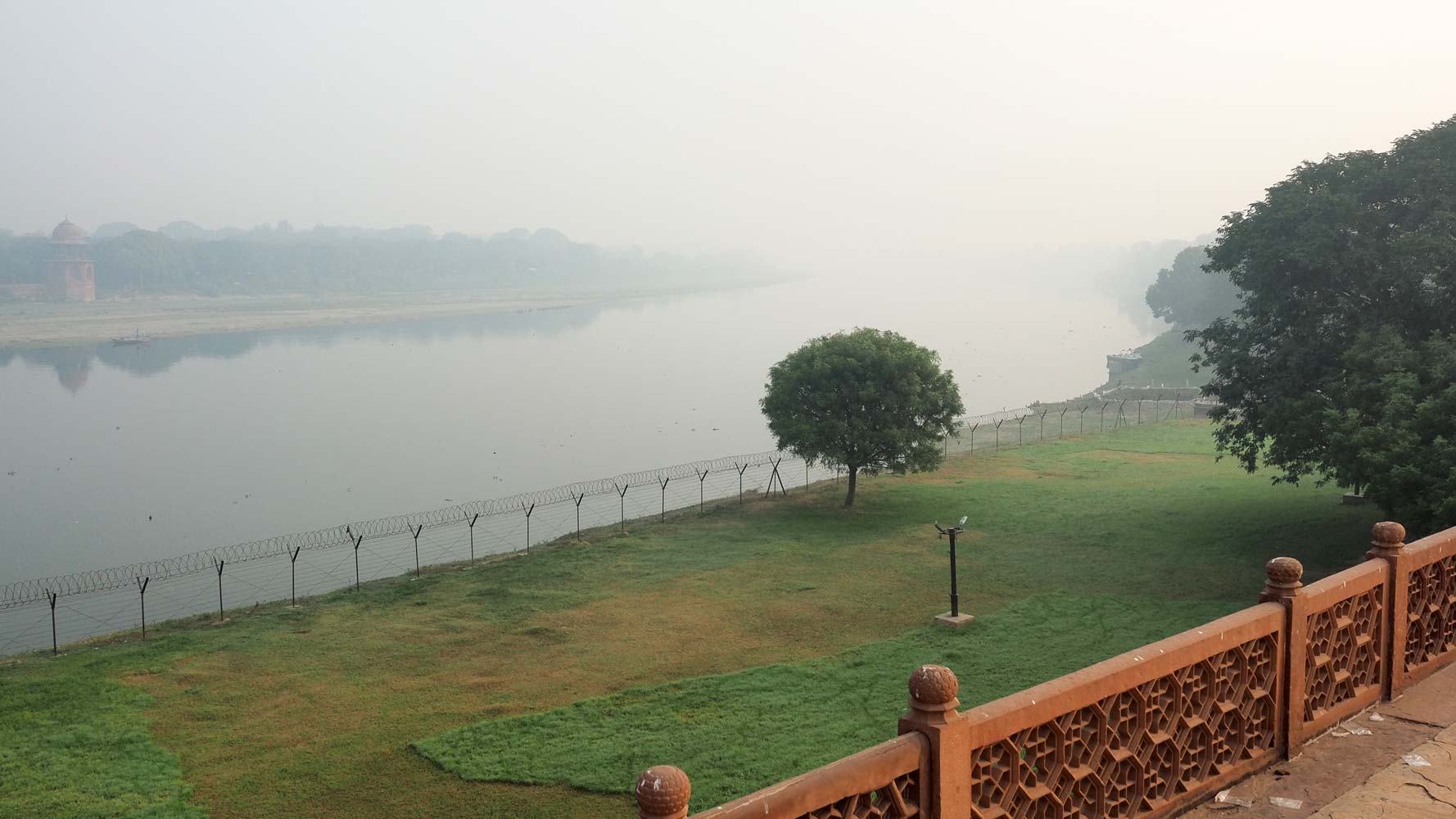
The Yamuna River fades
into the morning fog.
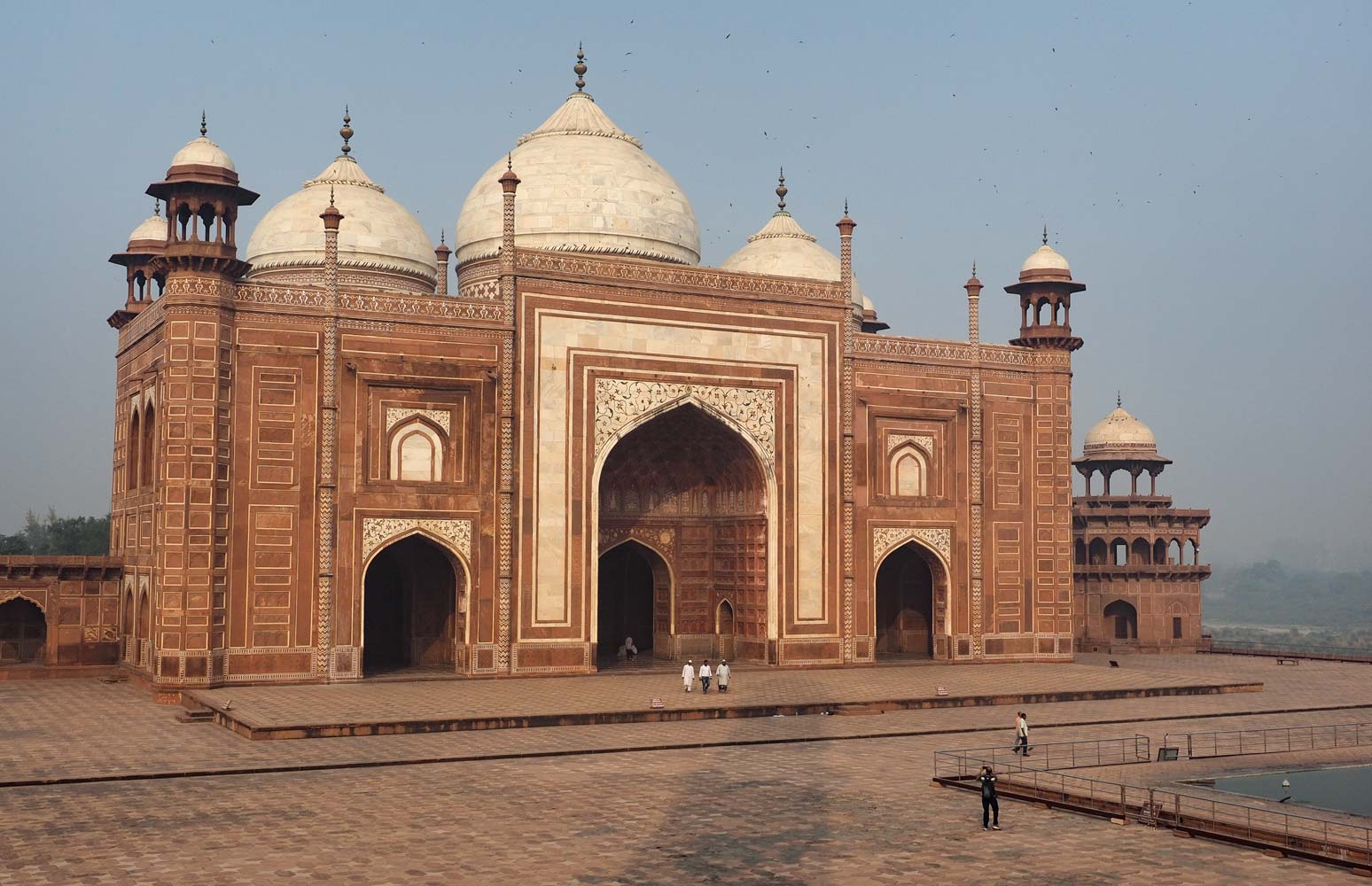
The mosque just west
of the Taj Mahal
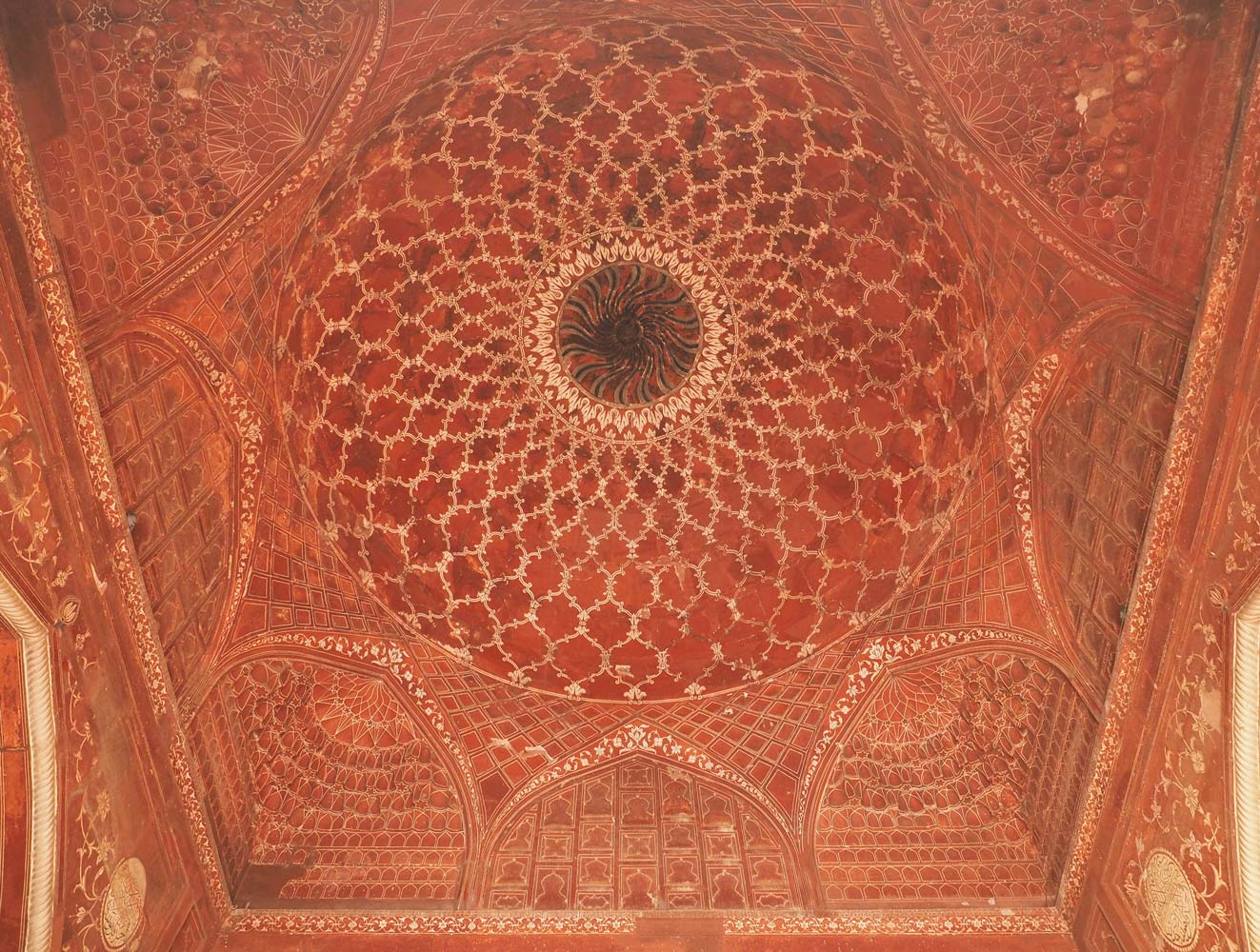
Mosque ceiling
Then I stepped into the white marble interior of the Taj and filed past a jewel–inlaid
latticed screen that surrounds the tombs of Mumtaz Mahal and her husband Emperor
Shah Jahan. (The actual tombs are said to lie below in an underground vault.) No
photos allowed inside, though. Shah Jahan built this memorial and tomb for his beloved
third wife, Mumtaz Mahal, who died while giving birth to their 14th child in 1631.
Construction began the year after her death and it took about eight years to build
the main tomb and about another 22 years to complete the complex.
After
exiting, I again wandered around the Taj to admire its beauty from many angles.
I also stepped inside a small museum, housed in an elegant building on the west
side of the formal garden, to see exhibits of old royal decrees, miniature paintings,
and samples of some of the many semi-precious stones used for inlays. I wandered
back out the Main Gate, then through the South Gate back to Taj Ganj, where I had
a late breakfast.

A stunning
structure
from every angle!
After a mid-day rest, I took an autorickshaw to Agra Fort, one of the finest Mughal forts of India. Emperor Akbar got it going in 1565, then Shah Jahan built highly refined palaces of white marble and red sandstone. Walls rise 20 meters, further protected by the Yamuna on one side and a crocodile-filled moat that curved around the other sides. I first visited the red sandstone Jehangir’s Palace, believed to have been constructed by Akbar for his son Jehangir. Then I meandered through a series of beautiful palaces that overlook the Yamuna to Diwan-i-Khas (Hall of Private Audiences) and the home of Shah Jahan’s famous Peacock Throne, once studded with precious gems including the Koh-i-noor Diamond, before later removal and dismantling. Next I turned inland to the imposing Diwan-i-Am (Hall of Public Audiences) and its central throne room where Shah Jahan once held court.

Amar Singh Gate,
now the main entrance to the Red Fort, has a dogleg design. (I first enter this
outer gateway.)
Amar Singh Gate
Amar Singh Gate (left) from inside the fort

Amazingly intricate
stone brackets of Jehangir’s Palace

The white marble Khas
Mahal, living quarters of Shah Jahan

A pool in the center
of the Khas Mahal
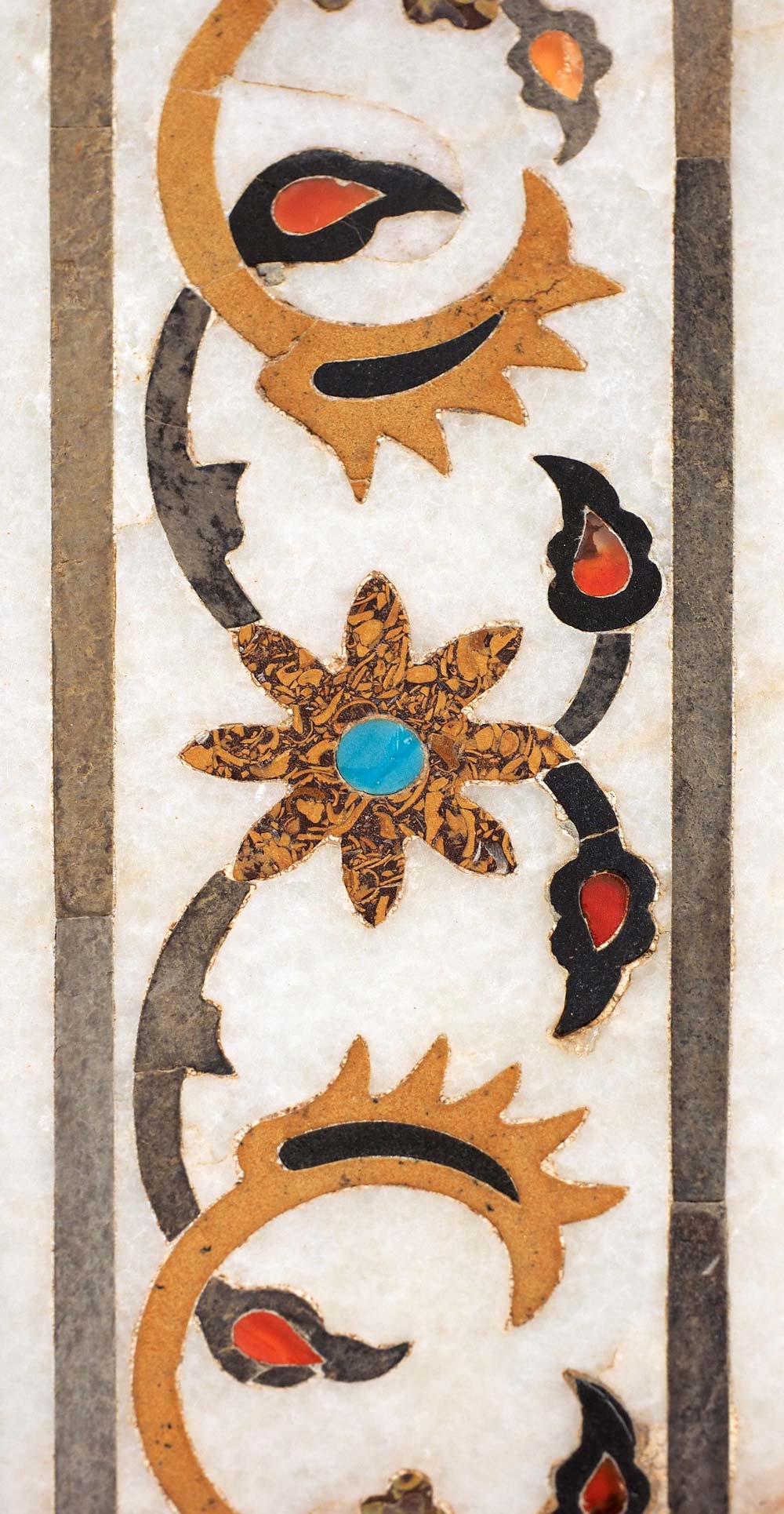
Pietra dura decorates
Khas Mahal.
A cycle rickshaw driver forged through thick traffic of Kinari Bazaar to Jama Masjid, built by a daughter of Shah Jahan in 1648. The red sandstone domes have striking zig-zag patterns from lines of white marble.

Crowded markets
surround Jama Masjid.
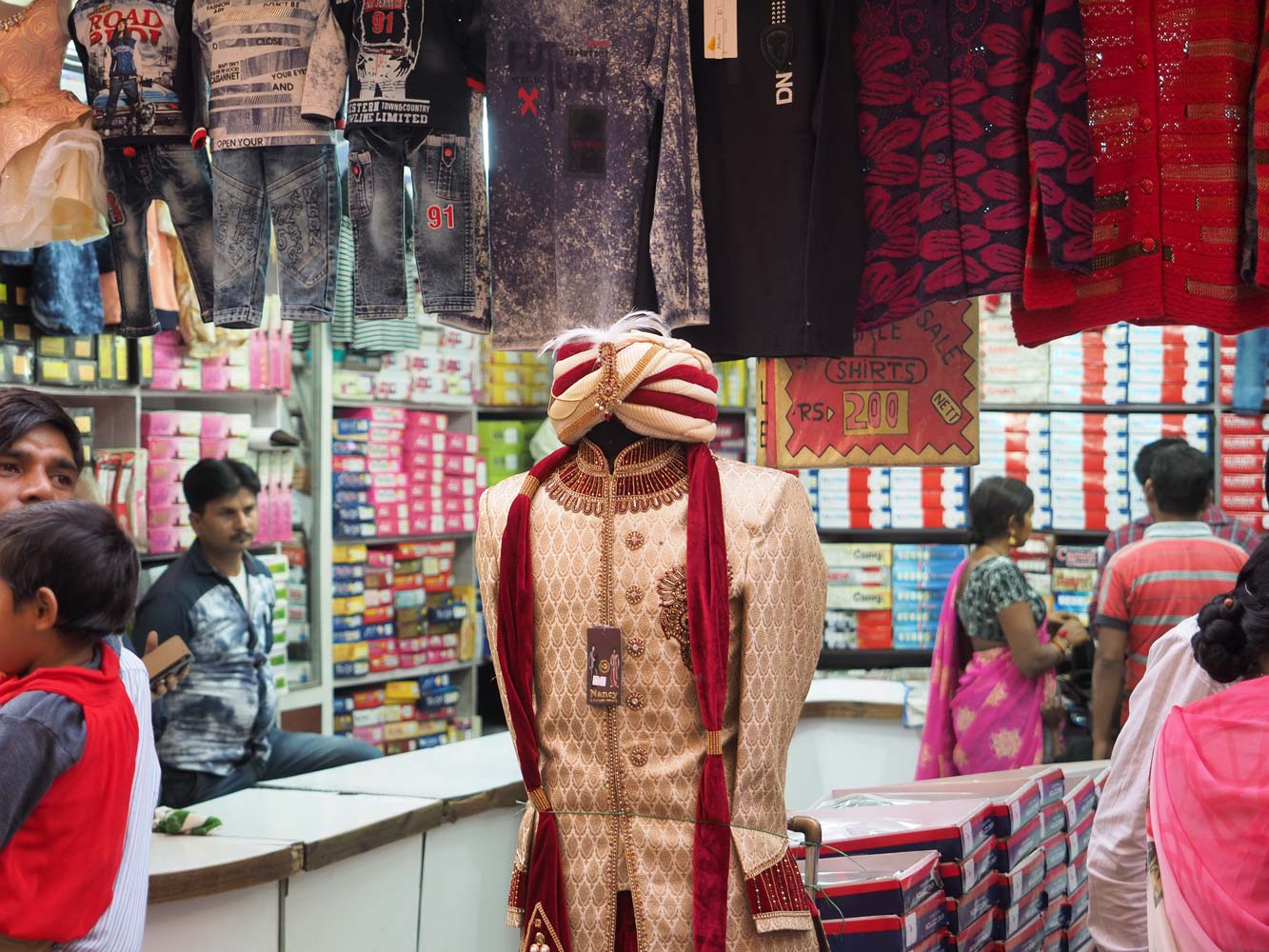
Clothing for all occasions
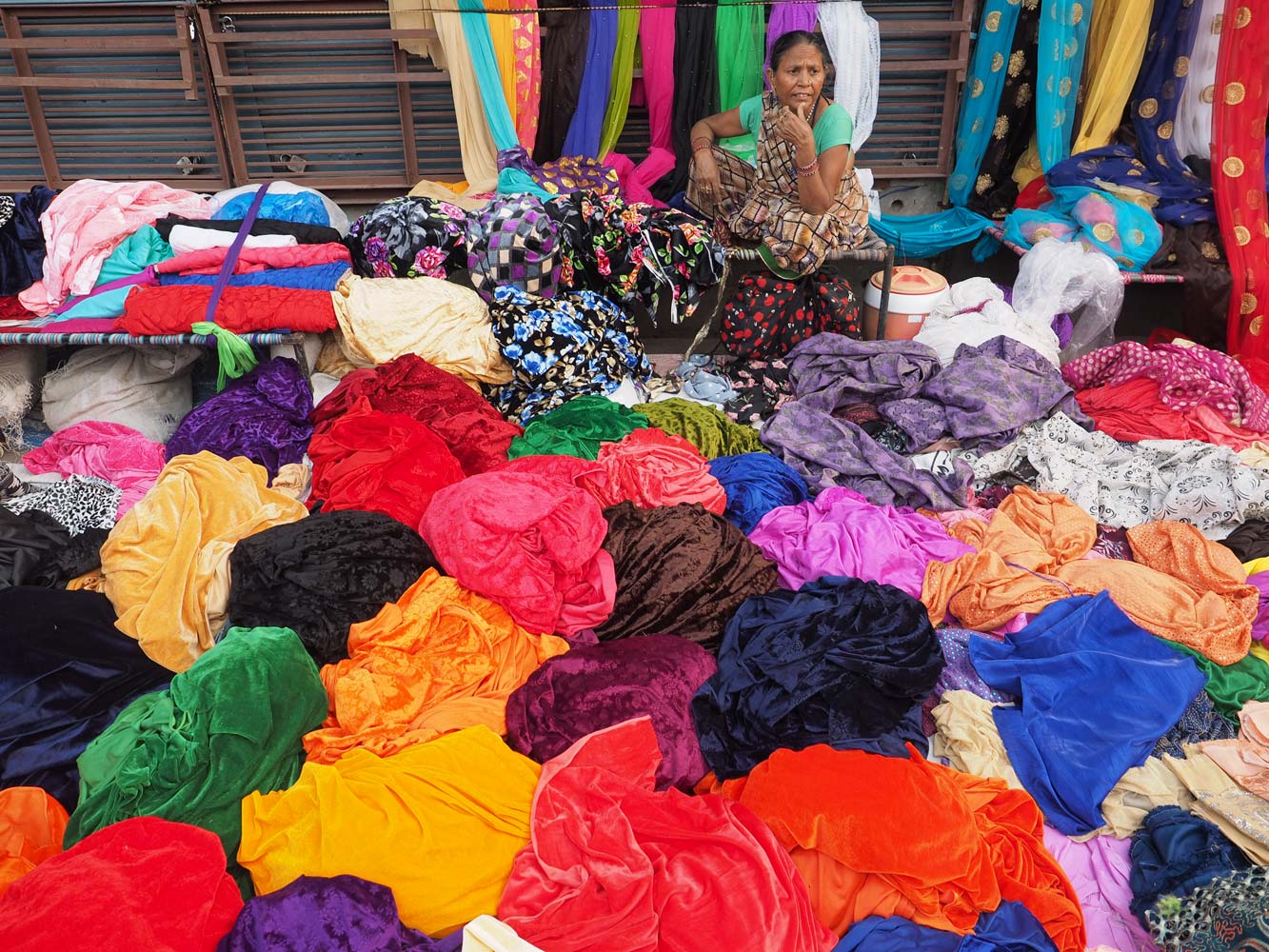
And in every color
imaginable!
An autorickshaw driver then dropped me off at Vedic Restaurant, next door to
last night’s Dakaprakash, where I had a tasty North Indian thali, then headed over
to Dakaprakash for a dreamy banana split.
31 Oct. Vrindavan
On
a hazy morning I enjoyed a leisurely breakfast, then packed up and loaded my bag
on an autorickshaw for a ride to the northwest edge of town and a visit to the Akbar
Mausoleum, which holds the remains of the greatest Mughal ruler. An exceptionally
large gateway of red sandstone has wonderful geometric designs and Islamic inscriptions
in white marble and dark stones. Four minarets rise at the corners. I left my backpack
here at the cloakroom and entered an enormous courtyard. Antelope, a creature that
appears in Mughal miniature paintings, grazed in green fields on either side of
the central raised walkway. Small waterways once ran along all the walkways and
filled pools, but all have now dried up. The mausoleum has what looks like a four-story
palace on top with a white marble lattice screen on the uppermost level. Elaborate
paintings cover the walls and ceiling of the entryway, and tomb markers, some in
translucent white marble, lay in chambers on either side. Then I followed a passageway
to the dimly lit and undecorated central chamber where Akbar’s tomb rests. Back
outside I walked around the mausoleum and detoured to the well-preserved north ‘gate.’
Although it’s just for symmetry and lacks a doorway, there is a balcony high up
inside the towering archway. An eastern ‘gate’ stands in semi-ruin with a collapsed
archway. The southern ‘gate’ is in better shape though didn’t have the extensive
paintings and rooftop details of the northern one. Several other buildings
stand outside the walled compound including a woman’s palace with intricate stonework
on the east side (the other side lost its façade) and a ruined octagonal tomb of
a Lodi ruler.

Gateway to Akbar
Mausoleum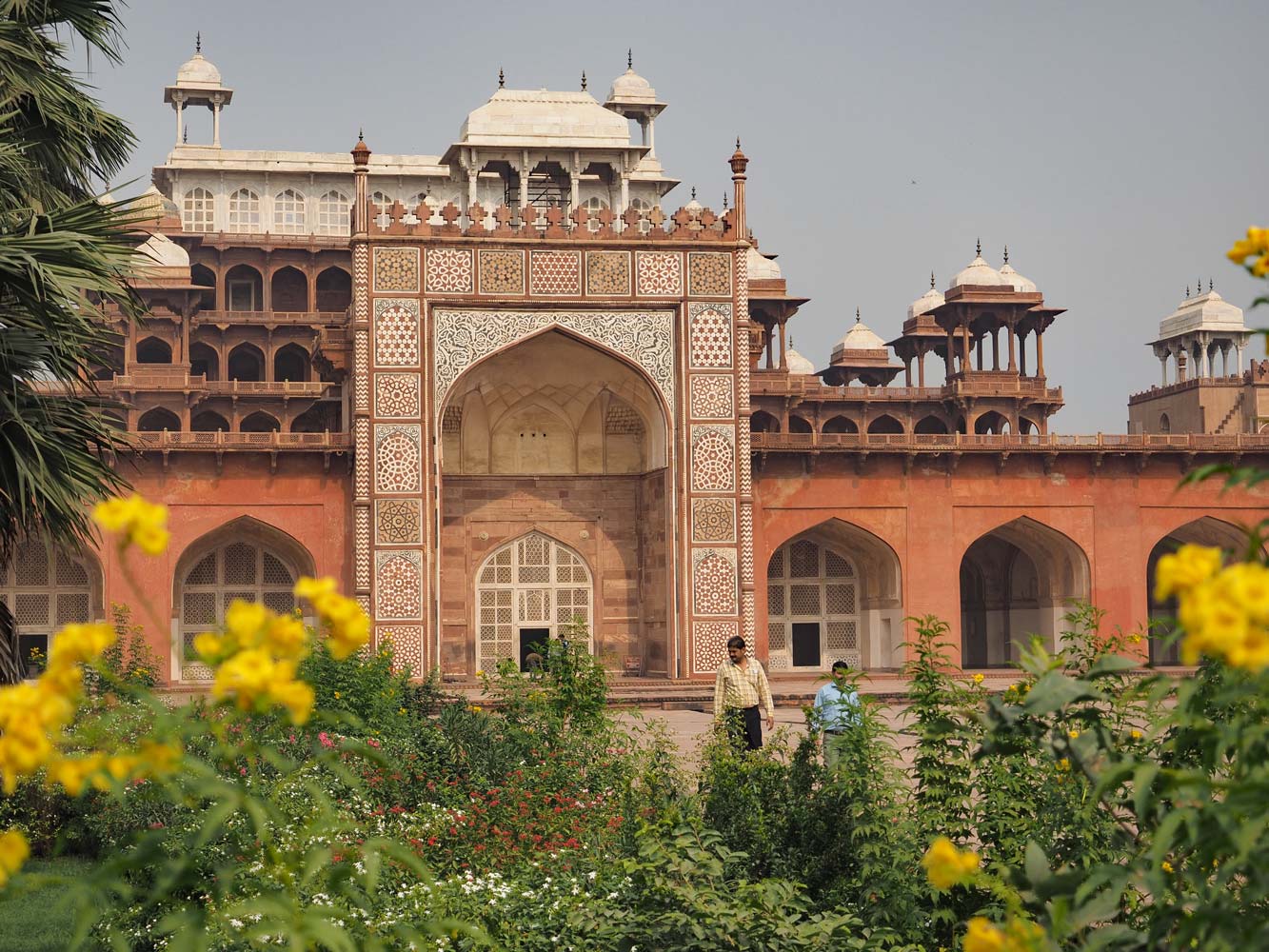
The
many-tiered Akbar Mausoleum
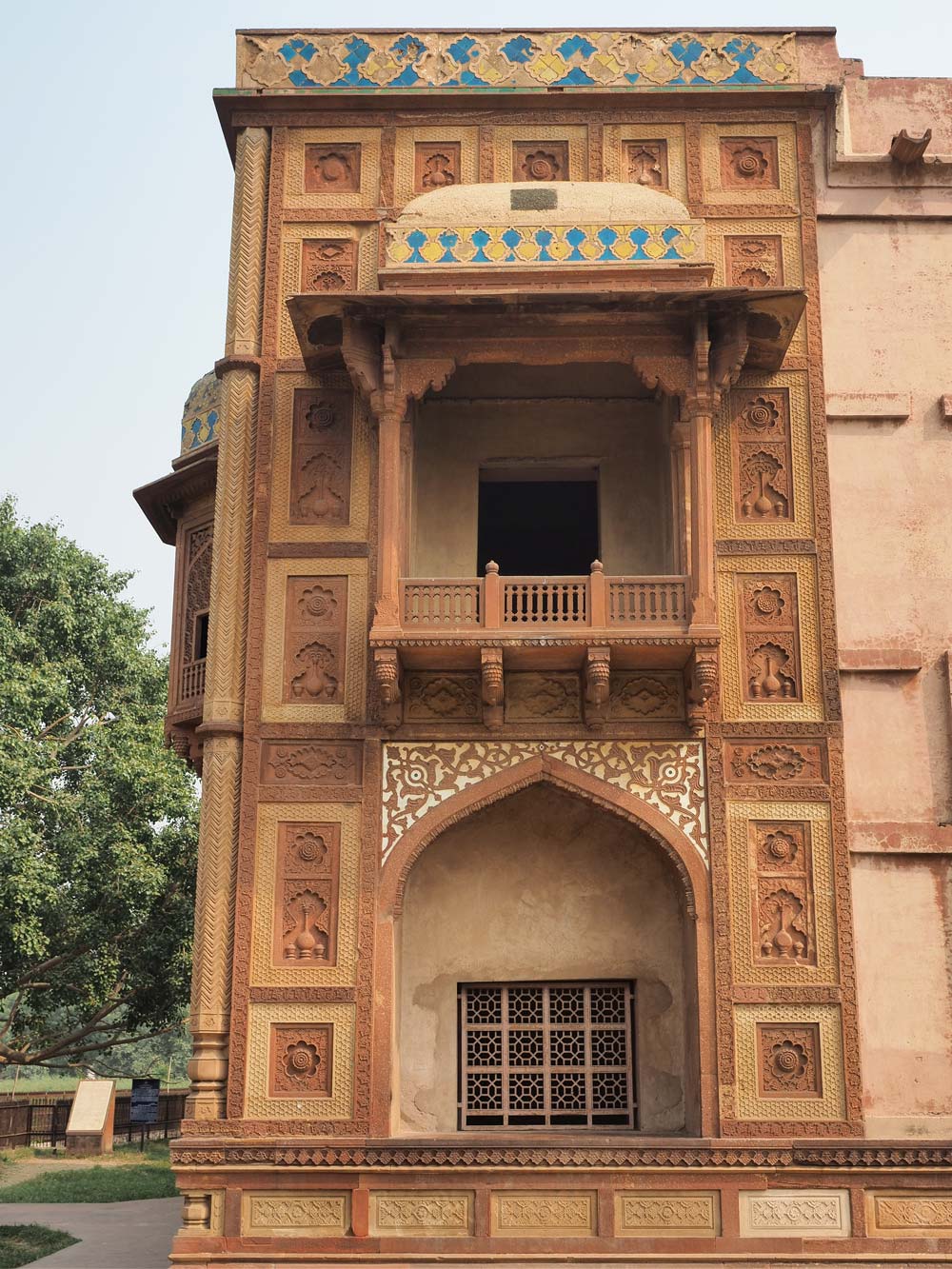
Corner detail
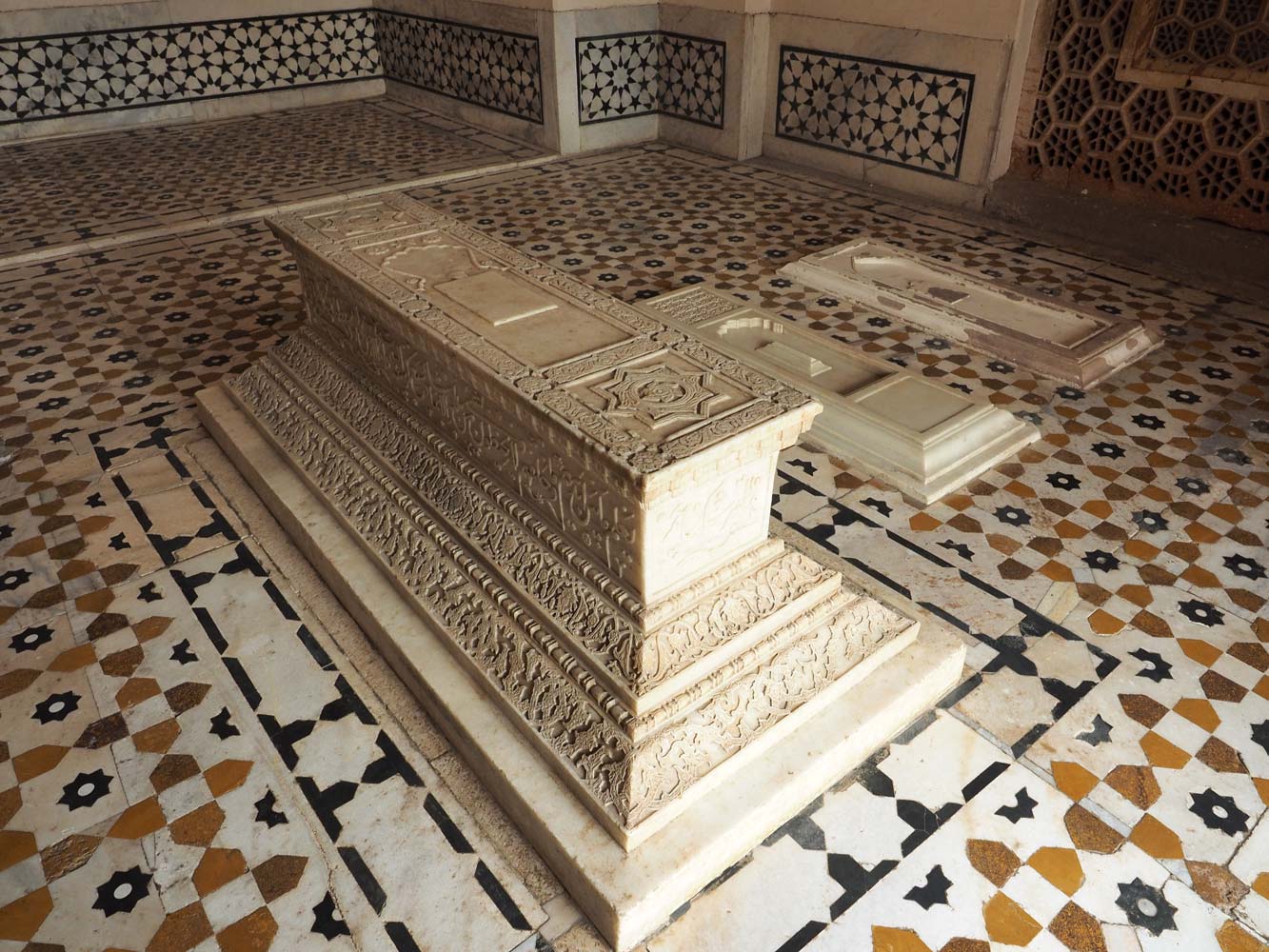
Grave markers inside
I could have tried to flag down a northbound bus from the highway, but it seemed
a better idea to take an autorickshaw for a short ride back toward town to the I.S.B.T.
bus station, where I found a roadside bus about to depart for Matura (pronounced
‘Matra’). I got seat in the packed interior, which always had room for another person
and bags! A few parts of the highway had wide and smooth pavement, but most turned
out to be bumpy and dusty and would have been unpleasant on a bicycle. In Mughal
times this route was the imperial highway from Agra to Delhi and roughly follows
the valley of the looping Yamuna River.
In the warren of rough narrow
streets of Matura, a temple town famed as the birthplace of Krishna, I got an autorickshaw
for the 13 kilometers to Vrindavan, a temple town in a bend of the Yamuna River
where Krishna grew up. The founder of the international Hare Krishna movement, Swami
Prabhupada (1896-1977) spent the last part of his life here and followers worship
at the Krishna Balaram Temple Complex. I saw many Westerners wearing Indian clothing.
Huge crowds filed along one of the streets to an all-night religious program.
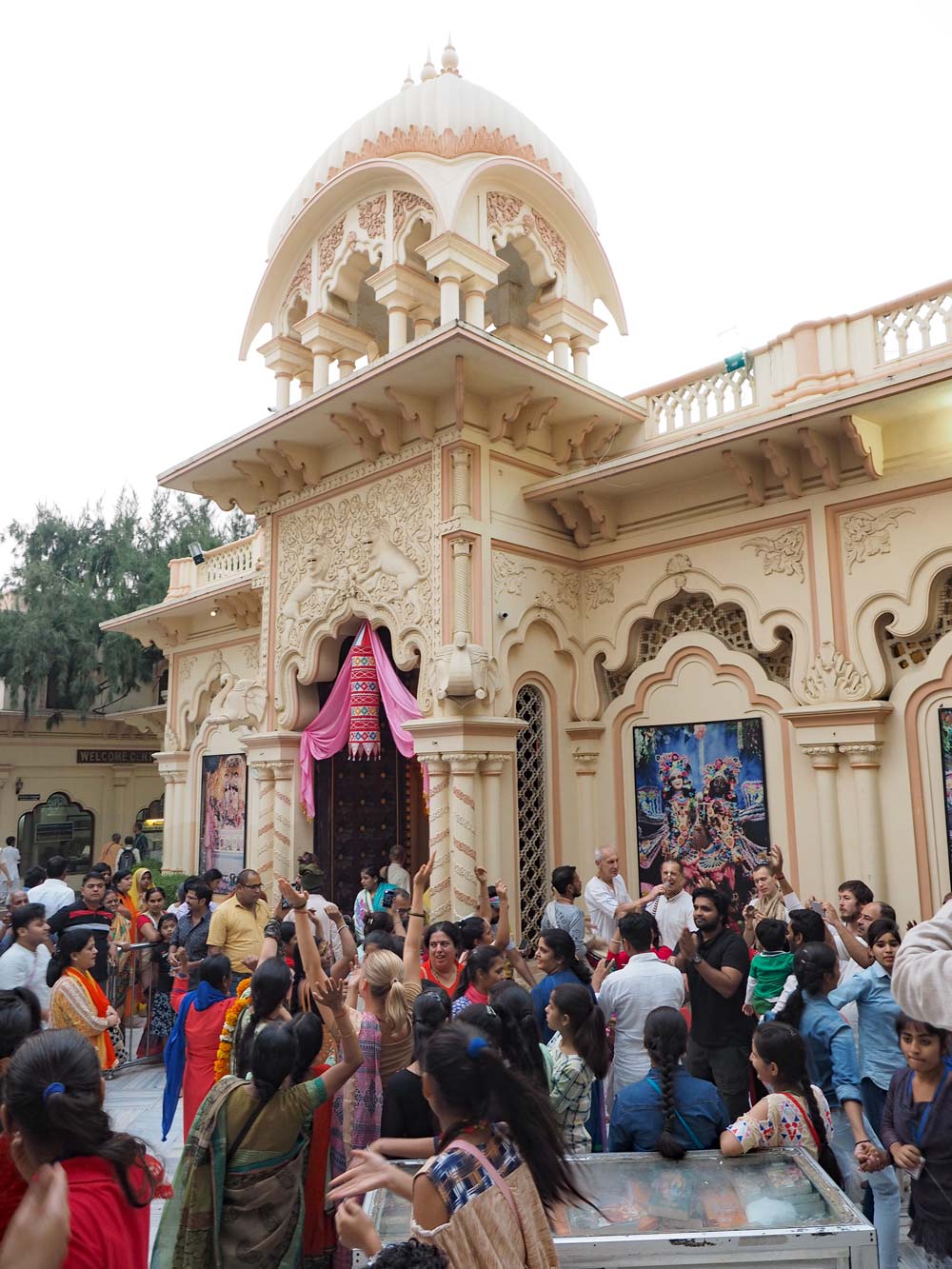
Devotional singing
at Krishna Balaram Temple Complex

Popular with both Indians
and Westerners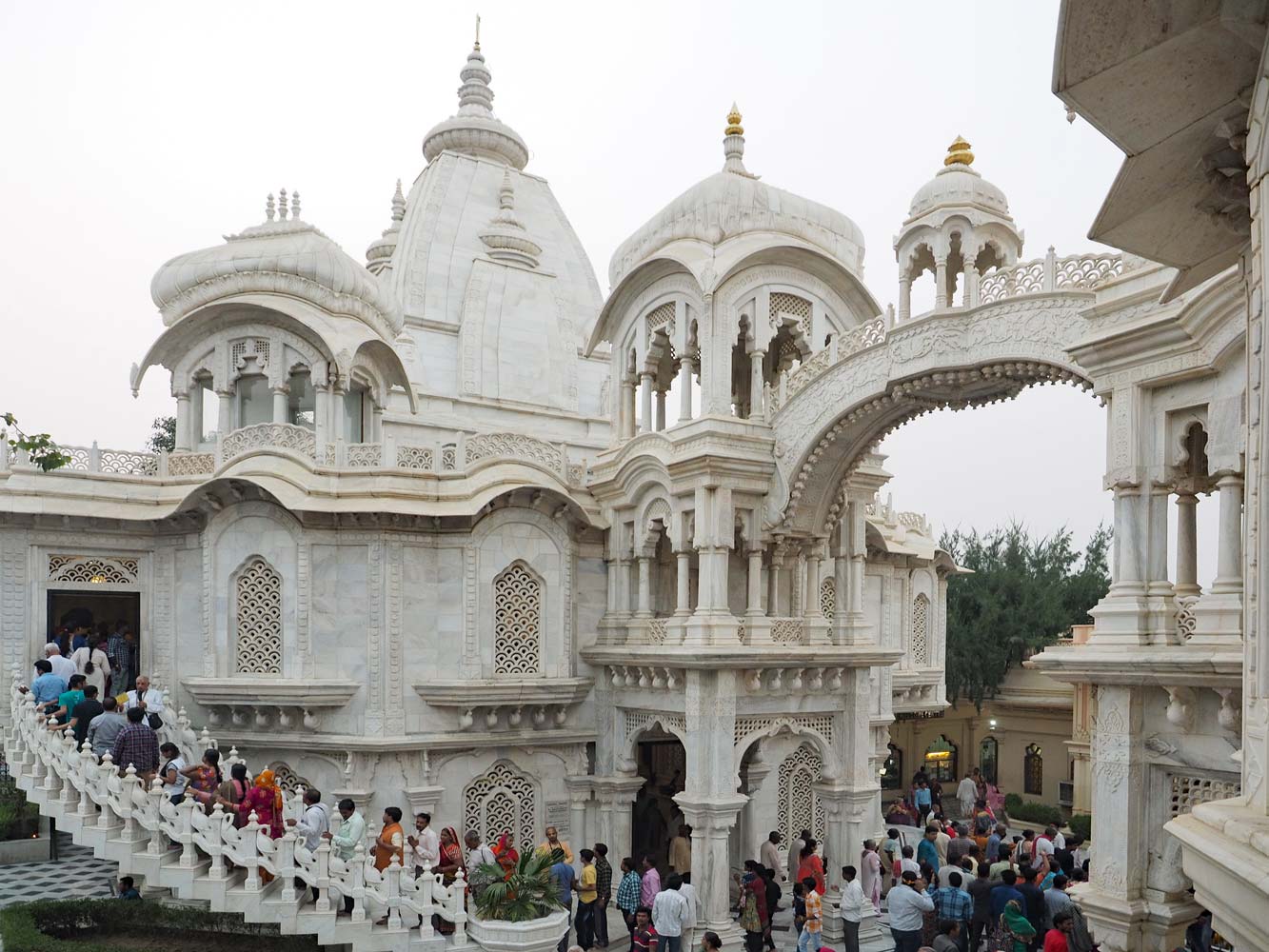
Worshipers patiently wait to enter.
An enquiry at a food stall about a place to stay led to a phone call and a fellow came out on a motorbike. He had an apartment for rent, and when the 1,500-rupee price came down to 1000 rupees I took it. Then the fellow took me back to the center where I entered the temple. The main hall, a courtyard with a white-marble entrance, has several colorful shrines of Krishna, his lady followers, Swami Prabhupada, and another teacher. A group of people sang devotional songs to the beat of drums and small cymbals. Outside another group of singers attracted enthusiastic dancers. On one side a shrine holds the remains of Swami Prabhupada. On the other side I climbed a set of stairs to a small museum with photos and story of the International Society for Krishna Consciousness (ISKCON). I had planned on dinner at the Govinda Restaurant in the temple complex, but it served only snacks. Farther down the street I came to an informal multi-cuisine restaurant and got a very tasty and filling North Indian vegetarian curry. I took an electric autorickshaw back to my apartment, a good thing as the dark streets would have been tricky on foot. Unfortunately I had picked up a cold from breathing the dusty air during the bus ride, and spent a somewhat restless night.